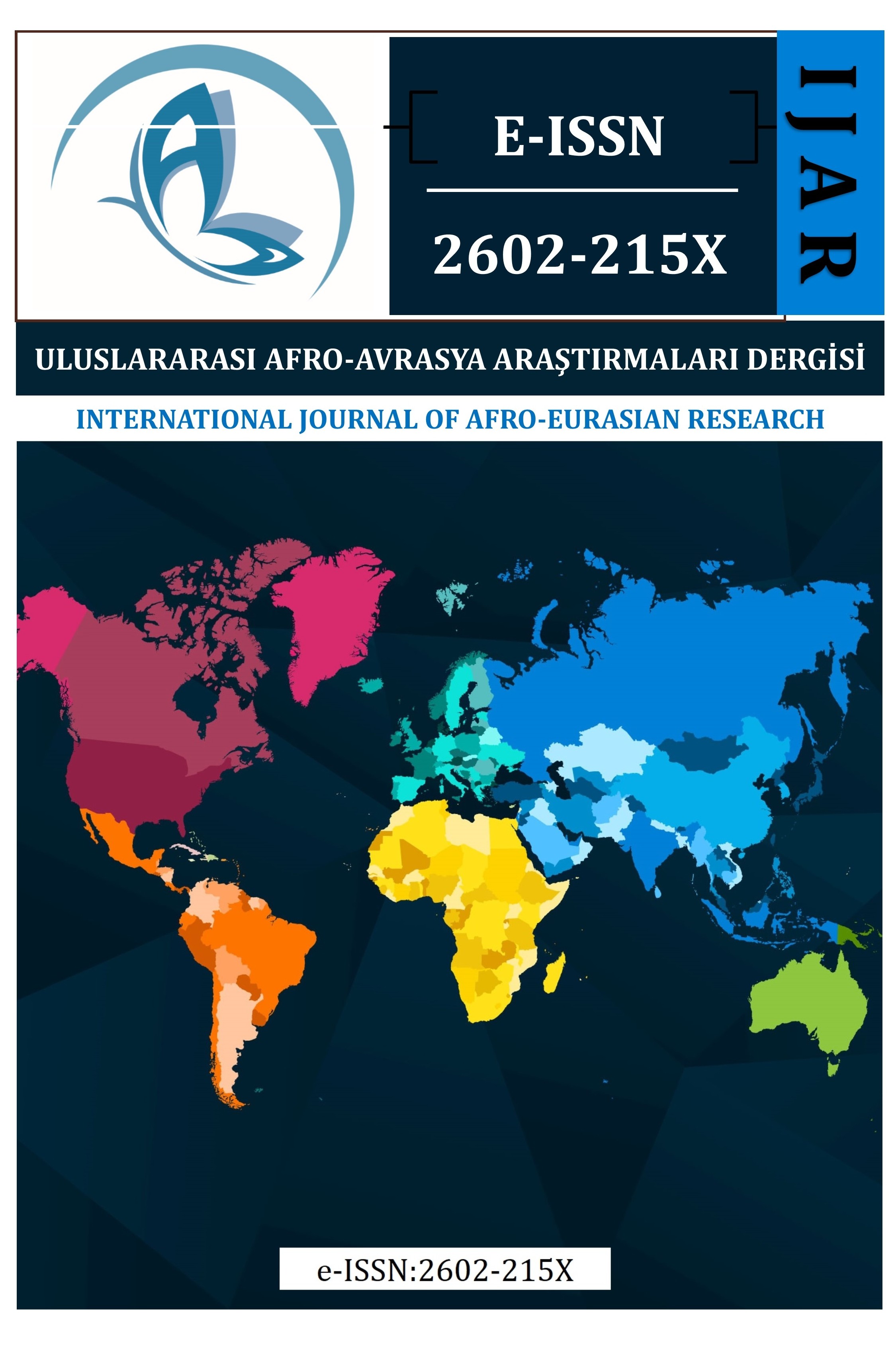ARAP KRİZİ’NİN SURİYE EKONOMİSİNE ETKİLERİ
2010 yılında Tahrir
meydanında başlayan olaylar ilk olarak yıllardır barışa ve huzura muhtaç bir
şekilde yaşayan Orta Doğu halkları için bir bahar şeklinde nitelendirilerek
Arap Baharı olarak adlandırılmıştır. Ancak geçen zamanla birlikte yaşananların
bahar olmadığı anlaşılmıştır. Bu sebeple Arap Krizleri olarak adlandırdığımız
bu olaylar, bölgede bulunan birçok ülkeye, Tunus’ta başlayıp ve sırasıyla
Libya, Bahreyn, Yemen, Ürdün, Mısır ve Suriye’ye, sıçramıştır. Bu krizlerin
birçoğu sona ermişken, Suriye’deki kriz devam etmektedir. Birçok devlet ve
devlet dışı aktörün bulunduğu bölgede yaşanan terör olayları ülkenin
ekonomisini de oldukça olumsuz bir şekilde etkilemiştir. Bu çalışmada, Arap
Krizleri ile başlayan ve hem devlet terörünün hem de devlet dışı aktörlerden
kaynaklanan terör olaylarının neticesinde kaydedilen ekonomik göstergeler
incelenerek ve literatürden faydalanılarak terör ile ekonomi arasındaki
bağlantı irdelenecektir.
Anahtar Kelimeler:
Terörizm, Ekonomi, Uluslararası Politik Ekonomi, Suriye, Arap Krizi
EFFECTS OF ARAB CRISIS TO THE SYRIAN ECONOMY
The events, which initiated in year of 2010, earlier qualified as spring for Middle Eastern people who indigent to peace and serenity for decades, and therefore named as Arab Spring. However, day by day, it is understood that events do not related with the any kind of spring, so that we identify the case as Arab Crisis. The crisis had started in Tunisia and then spread to Libya, Bahrein, Yemen, Jordan, Egypt and Syria. Many of the this series of crisis ended, except Syria. The events in the area, where include a lot of actors as state and non-state, affected negatively country’s economy. In this paper, economic indicators which are result of the Arab Crisis and terrorist activities, that are made by both regime and sub-state groups, in the country will be examined and correlation between terrorism and economy will be scrutinized.
Keywords:
Terrorism, Economy, International Political Economy, Syria, Arab Crisis,
___
- Akgün, B. (2006). “Küresel terör: mit mi?, gerçek mi?”. In Gökçe O., Demiray U. ed., Terörün görüntüleri, görüntülerin terörü, Konya: Çizgi Kitabevi.
- Berman, E. and Laitin, D.D. (2008). Religion, terrorism and public goods, Journal of Public Economics, 92, 1942–67.
- BP. (2017). “BP Statistical Review of World Energy.” https://www.bp.com/ content/dam/bp/en/corporate/pdf/energy-economics/statistical-review-2017/bp-statistical-review-of-world-energy-2017-full-report.pdf.
- Caruso, R. and Schneider, F. (2011). The socio-economic determinants of terrorism and political violence in Western Europe (1994–2007), European Journal of Political Economy, 27, 37–49.
- Syrian Center for Policy Research. (2016). “Confronting Fragmentation.”. 11 February 2016, http://scpr-syria.org/publications/policy-reports/ confronting -fragmentation/. (Accessed on 14 September 2017).
- Food and Agriculture Organization of United Nations. (2017). “Counting the cost Agriculture in Syria after six years of crisis.”. http://www.fao.org/3/b-i7081e.pdf.
- Institute of Economics and Peace. (2016). “Global Terrorism Index 2016.”. http://visionofhumanity.org/app/uploads/2017/02/Global-Terrorism-Index-2016.pdf.
- UN ve Google. (2017). “Suriye mercek altında.”, https://searchingforsyria.org/tr
- UN ESCWA. (2016). “Syria At War Five Year On.”. UN House: Beirut.
- Central Bureau of Statistic Syrian Arab Republic. (2017). Consumer Price Index, cbssyr.sy/CPI; Country Report Syria.
- Enders, W. and Sandler, T. (2006). The Political Economy of Terrorism, Cambridge University Press, New York.
- Trade Economics. (2017). Country Report Syria., www.tradeeconomics.com /country/syria.
- Dedeoğlu, B. (2003). “Terörizm üzerine karşılaştırmalar: Bermuda şeytan üçgeni”. In Dedeoğlu, B. ed., Dünden bugüne avrupa birliği, İstanbul: Boyut Kitapları.
- Development of inflation rates in Syria. World Data, https://www.worlddata. info /asia/syria/inflation-rates.php
- El Dahan, M. (2016). “Syrian food crisis deepens as war chokes farming,” Reuters, 26 April 2016, https://www.reuters.com/article/us-mideast-crisis-syria-wheat/syrian-food-crisis-deepens-as-war-chokes-farming-idUSKCN0XN0G0.
- Engdahl, W. (2015). “Genies and Genocide: Syria, Israel, Russia and Much Oil”, NSNBC International, 26 October 2015, https://nsnbc.me/2015 /10/26/genies-and-genocide-syria-israel-russia-and-much-oil/. (Accessed on 12 September 2017).
- Lijphart, A. (1971) Class voting and religious voting in the European democracies, Acta Politica, 6, 158–71.
- Parker, J. (2012). Economics. Portland: Reed College. http://www.reed.edu/economics/parker/s12/314/Coursebook/Ch_01.pdf.
- Ross, S. (2016). “Top 5 Ways Terrorism Impacts the Economy,” Investopedia, 21 August 2016, http://www.investopedia.com/articles/markets/ 080216/top-5-ways-terrorism-impacts-economy.asp.
- SIPRI. (2017). SIPRI Yearbook 2017 Summary, https://www.sipri.org/ sites/default/files/2017-09/yb17-summary-eng.pdf.
- Başlangıç: 2016
- Yayıncı: Hakan ARIDEMİR
Sayıdaki Diğer Makaleler
ARAP KRİZİ’NİN SURİYE EKONOMİSİNE ETKİLERİ
SOSYALİST BİR ROMAN: KARAGANDI
HAYÂLÎ BEY’İN GAZELLERİNDE SÖZ SANATLARINA DAYALI ÂHENK UNSURLARI
ABAY KUNANBAY ŞİİRLERİNİN METİNLERARASILIK POTANSİYELİ
Temirgali Esembekov, Aygül Şengün
TÜRKİYE’DEKİ HİDROELEKTRİK SANTRALİ (HES) UYGULAMALARINA ÇEVRE AÇISINDAN BAKIŞ
MUSTAFA NECATİ SEPETÇİOĞLU’NUN “KUTSAL MAHPUS- EBU HANİFE” ROMANINDA HALK BİLİMİNİN İZLERİ
AFRO-ARAP MEDYA ARAŞTIRMACILARININ YENİ MEDYAYI BİR BİLGİ KAPİTALİZASYON ARACI OLARAK KULLANMASI
TÜRKİYE’DEKİ SURİYELİ GÖÇMENLERİN SİYASİ VE HUKUKİ DURUMU
ALTERNATİF MEDYA VE SİNEMA İLİŞKİSİNE BİR ÖRNEK: EKŞİ SİNEMA WEB SAYFASI ÜZERİNE BİR DEĞERLENDİRME
